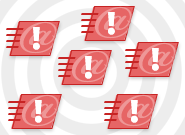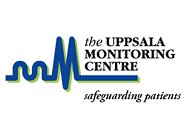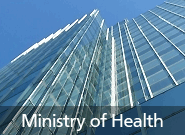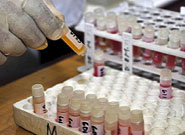Day 4: Thursday 21 April 2011
There is an e-mail on your desk from Dr Maia Rayon:
From: Dr Rayon, Maia
To: J. Lombard
Subject: Stopped use of the Klinigen measles vaccine
"Dear J. Lombard
This is to confirm that we stopped use of the Klinigen measles vaccine batch U-5773 yesterday, and have had confirmation from all immunization centres that it was last used on Tuesday 18 April at nine centres in Karoomana and Weston. I think that we should have contained the problem. We will carefully follow up on potentially upcoming events and AEFI reports, which we do not yet know about.
Dr Maia Rayon,
National Immunization Programme Director"
There is also a telephone message from Gunther Stiegman at Klinigen, requesting that you call him back.
Select the activities that you will do next.

Telephone Gunther Stiegman.

Gunther Stiegman tells you that they have tested their reserve vials of the measles vaccine and they have found that it is contaminated with lipopolysaccharide, and this would explain why a number of children are developing the symptoms. One other country has received the sample, But however no other cases have been reported from there.
- Contacting the manufacturer to receive information on the cause of the event is a highly relevant activity.
They have informed UNICEF and issued an urgent recall on all vials of the affected batch.
- This explains why the children are affected and confirms that you are dealing with a vaccine reaction.

Send an alert to UNICEF and the Uppsala Monitoring Centre.

You send urgent e-mails to UNICEF and UMC (info@who-umc.org), and make sure that the AEFI reports are transmitted to UMC.
You say that a full report will follow early next week.
- This is an important and correct action. UNICEF is the vaccine procurer, and they know exactly where the batch has been distributed.
- UMC will be able to collect the data and check for signals that may have occurred in other countries.

Arrange to go on a vaccine pharmacovigilance training course at UMC.

UMC's International Training Course are run annually.
The course is open to Health Care Professionals, e.g. physicians, pharmacists, nurses, who have recently become engaged or soon will become engaged in the practical operation of pharmacovigilance programmes in a hospital, community, regulatory, university or industry setting.
- Module I covers an introduction to ADRs and spontaneous adverse reaction reporting;
- Module II offers an option of (a) an introduction to pharmacoepidemiology or (b) effective communications in pharmacovigilance.
Theoretical and practical aspects of adverse drug reactions and pharmacovigilance are covered.
- This action is not of immediate priority, but will be very useful for you in the medium term to ensure that you are up-to-date on best pharmacovigilance practices.
- For further information, visit the UMC website96.

Write a report for your Minister of Health.

This report should:
- Inform of the cluster associated with the delivery of the Measles vaccination,
- Identify the Batch [number] of the vaccine used,
- Describe the nature and time of the event and the number of cases/fatalities (potentially also including post mortem results if available),
- Provide a summary of scientific information available that could serve as additional helpful background information,
- Provide additional information/advice from key experts, e.g. members of the AEFI review committee,
- Reflect information exchange with the vaccine manufacturer,
- Mention which action has been taken at local level, (e.g. suspension / withdrawal of the batch) and provide information how vaccines were disposed off at the local level. Describe steps taken to prevent the batch from being accidently reused,
- Clarify on next steps, in particular with sharing information at international level (UNICEF, WHO, UMC).
- Putting time into providing a complete report is very relevant to ensure effective communication on the event.
- A report is required – it is part of your reporting line within Reganda. You will draft such a report at the endpoint of this case study.

Send information on the cluster of AEFIs to all five regional health officers.

This information could:
- Inform of the cluster associated with the delivery of the Measles vaccination.
- Identify the Batch [number] of the vaccine used.
- Describe the nature and time of the event and the number of cases/fatalities (potentially also including post mortem results if available).
- Provide a summary of scientific information available that could serve as additional helpful background information.
- Provide additional information/advice from key experts, e.g. members of the AEFI review committee.
- Reflect information exchange with the vaccine manufacturer.
- Mention which action has been taken at local level, (e.g. suspension / withdrawal of the batch) and provide information how vaccines were disposed off at the local level. Describe steps taken to prevent the batch from being accidently reused.
- Clarify on next steps, in particular with sharing information at international level (UNICEF, WHO, UMC).
- This action should be coordinated with the NIP, who will also be informing the immunization programme managers what has happened.
- It is important that the information from the NRA and the NIP is fully consistent.

Request an update on any new AEFI cases related to the measles vaccine.

You ask whether any more AEFI reports have arrived. Shara provides you with two more reports – one from Weston Province and one from Karoomana. They both describe convulsions related to the measles vaccination of the suspect batch. Fortunately, both children recovered fully.
She updates the map on your wall. There are now 12 cases in the cluster on the map.
- This is relevant, as some AEFI reports may come in after a vaccine has stopped being used.
- It is encouraging that the number of reports in this case study is now starting to fall.

Request the laboratory report from your national reference laboratory.

The head of the laboratory tells you that they tested vials of the affected vaccine from Karoomana, which all turned out to be non-microbiologically contaminated. They could not find anything faulty with them.
- A laboratory can only carry out certain tests. Clearly there is a problem with this batch of vaccine, but it is a problem of microbiological contamination. Another laboratory may be able to do more appropriate tests to identify exactly what the problem is.

